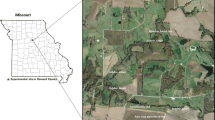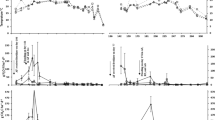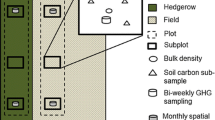Abstract
Controlled tile drainage (CTD) can benefit the environment and crop production. However, CTD has the potential to increase soil greenhouse gas (GHG: CO2, CH4, N2O) emissions by increasing soil water contents and elevating field water levels. A paired-field (CTD and uncontrolled tile drainage (UTD)) approach was used to compare soil GHG emissions for silt loam corn, soybean, and forage fields under CTD and UTD management in eastern Ontario, Canada during a drier and a wetter growing season. A total of five field pairs were examined. Soil GHG emissions directly over tile drains (OT) and between tile drains (BT) in the CTD fields were also assessed. Average soil GHG emissions did not significantly differ (p > 0.05) for CTD and UTD field pairs, except for CO2 emissions (greater emissions from UTD fields) among two field pairs studied (forage in the drier growing season and soybean in the wetter growing season), and N2O emissions from a soybean field pair in the wet growing season (greater emissions from CTD field). Significantly higher soil water contents in the UTD forage field may have augmented CO2 fluxes there. There were some significantly higher N2O (in the wetter growing season) and CO2 emissions (in both growing seasons) BT relative to OT locations in some fields; but these differences were not translated significantly to other BT and OT site comparisons. The wetter growing season examined resulted in greater average daily soil CO2 fluxes overall, but similar CH4 and N2O fluxes for soybean fields compared to soybean fields in the drier growing season. Overall, there were no spatially or temporally systematic differences in GHG emissions among CTD and UTD field pairs, or among BT and OT locations in CTD fields.







Similar content being viewed by others
References
American Public Health Association (2005) Standard methods for the examination of water and wastewater, 21st edn. APHA, Washington
Aulakh MS, Doran JW, Mosier AR (1992) Soil denitrification—significance, measurement, and effects of management. In: Stewart BA (ed) Advances in soil science. Springer, New York, NY, pp 1–57
Ball BC, Scott A, Parker JP (1999) Field N2O, CO2, and CH4 fluxes in relation to tillage, compaction and soil quality in Scotland. Soil Till Res 53(1):29–39
Ball-Coelho BB, Murray R, Lapen D, Topp E, Bruin A (2012) Phosphorus and sediment loading to surface waters from liquid swine manure application under different drainage and tillage practices. Agric Water Manag 104:51–61
Blandford D, Gaasland I, Vårdal E (2014) The trade-off between food production and greenhouse gas mitigation in Norwegian agriculture. Agric Ecosyst Environ 184:59–66
Bowden RD, Newkirk KM, Rullo GM (1998) Carbon dioxide and methane fluxes by a forest soil under laboratory-controlled moisture and temperature conditions. Soil Biol Biochem 30(12):1591–1597
Bremner JM, Blackmer AM (1978) Nitrous oxide: emission from soils during nitrification of fertilizer nitrogen. Science 199(4326):295–296
Bustamante M, Robledo-Abad C, Harper R, Mbow C, Ravindranat NH, Sperling F, Haberl H, Siqueira Pinto A, Smith P (2014) Co-benefits, trade-offs, barriers and policies for greenhouse gas mitigation in the agriculture, forestry and other land use (AFOLU) sector. Glob Change Biol 20(10):3270–3290
Chadwick DR, Pain BF (1997) Methane fluxes following slurry applications to grassland soils: laboratory experiments. Agric Ecosyst Environ 63:51–60
Chan AKA, Parkin TB (2001) Effect of land use on methane flux from soil. J Environ Qual 30:786–797
Cheng W (1996) Measurement of rhizosphere respiration and organic matter decomposition using natural 13C. Plant Soil 183(2):263–268
Cicek H, Sunohara M, Wilkes G, McNairn H, Pick F, Topp E, Lapen DR (2010) Using vegetation indices from satellite remote sensing to assess corn and soybean response to controlled tile drainage. Agric Water Manag 98(2):261–270
Crabbé P, Lapen DR, Clark H, Sunohara M, Liu Y (2012) Economic benefits of controlled tile drainage: watershed evaluation of beneficial management practices, South Nation river basin, Ontario. Water Qual Res J Can 47(1):30–41
Datta A, Smith P, Lal R (2013) Effects of long-term tillage and drainage treatments on greenhouse gas fluxes from a corn field during the fallow period. Agric Ecosyst Environ 171:112–123
Davidson EA, Verchot LV, Cattânio JH, Ackerman IL, Carvalho JEM (2000) Effects of soil water content on soil respiration in forests and cattle pastures of eastern Amazonia. Biogeochemistry 48(1):53–69
Dobbie KE, Smith KA (2001) The effects of temperature, water-filled pore space and land use on N2O emissions from an imperfectly drained gleysol. Eur J Soil Sci 52(4):667–673
Dobbie KE, Smith KA (2003) Nitrous oxide emission factors for agricultural soils in Great Britain: the impact of soil water-filled pore space and other controlling variables. Glob Change Biol 9(2):204–218
Dobbie KE, Smith KA (2006) The effect of water table depth on emissions of N2O from a grassland soil. Soil Use Manag 22(1):22–28
Dobbie KE, McTaggart IP, Smith KA (1999) Nitrous oxide emissions from intensive agricultural systems: variations between crops and seasons, key driving variables, and mean emission factors. J Geophys Res Atmos 104(D21):26891–26899
ECCC (2015) Environment and Climate Change Canada, Russel Station, ON. Canadian climate normals 1981–2010. http://climate.weather.gc.ca/climate_normals/results_1981_2010_e.html?stnID=4376&autofwd=1. Date modified 2015-02-11. Accessed 14 Oct 2015
ECCC (2016) National inventory report 1990–2014: greenhouse gas sources and sinks in Canada—executive summary. https://www.ec.gc.ca/ges-ghg/default.asp?lang=En&n=662F9C56-1. Date modified 2016-04-14. Accessed 13 Sept 2016
Elmi A, Madramootoo C, Hamel C (2000) Influence of water table and nitrogen management on residual soil NO3 − and denitrification rate under corn production in sandy loam soil in Quebec. Agric Ecosyst Environ 79(2):187–197
Elmi A, Burton D, Gordon R, Madramootoo C (2005) Impacts of water table management on N2O and N2 from a sandy loam soil in southwestern Quebec, Canada. Nutr Cycl Agroecosys 72(3):229–240
Frank AB, Libig MA, Hanson JD (2002) Soil carbon dioxide fluxes in northern semiarid grasslands. Soil Biol Biochem 34(9):1235–1241
Frey SK, Hwang HT, Park YJ, Hussain SI, Gottschall N, Edwards M, Lapen DR (2016) Dual permeability modeling of tile drain management influences on hydrologic and nutrient transport characteristics in macroporous soil. J Hydrol 535:392–406
Gilliam JW, Skaggs RW, Weed SB (1979) Drainage control to diminish nitrate loss from agricultural fields. J Environ Qual 8(1):137–142
Glenk K, Eory V, Colombo S, Barnes A (2014) Adoption of greenhouse gas mitigation in agriculture: an analysis of dairy farmers’ perceptions and adoption behaviour. Ecol Econ 108:49–58
Grant R, Pattey E (1999) Mathematical modeling of nitrous oxide emissions from an agricultural field during spring thaw. Glob Biogeochem Cycl 13:679–694
Gregorich EG, Rochette P, VandenBygaart AJ, Angers DA (2005) Greenhouse gas contributions of agricultural soils and potential mitigation practices in eastern Canada. Soil Till Res 83:53–72
Hernandez-Ramirez G, Brouder SM, Smith DR, Van Scoyoc GE (2009) Greenhouse gas fluxes in an eastern corn belt soil: weather, nitrogen source, and rotation. J Environ Qual 38(3):841–854
Jacinthe P, Dick WA, Brown LC (2000) Bioremediation of nitrate-contaminated shallow soils and waters via water table management techniques: evolution and release of nitrous oxide. Soil Biol Biochem 32(3):371–382
Jaynes DB, Isenhart TM (2014) Reconnecting tile drainage to riparian buffer hydrology for enhanced nitrate removal. J Environ Qual 43(2):631–638
Keller M, Reiners WA (1994) Soil-atmosphere exchange of nitrous oxide, nitric oxide, and methane under secondary succession of pasture to forest in the Atlantic lowlands of Costa Rica. Global Biogeochem Cycl 8(4):399–409
Kliewer BA, Gilliam JW (1995) Water table management effects on denitrification and nitrous oxide evolution. Soil Sci Soc Am J 59(6):1694–1702
Knowles R (1982) Denitrification. Microbiol Rev 46(1):43–70
Levine UY, Teal TK, Robertson GP, Schmidt TM (2011) Agriculture’s impact on microbial diversity and associated fluxes of carbon dioxide and methane. ISME J 5(10):1683–1691
Linn DM, Doran JW (1984) Effect of water-filled pore space on carbon dioxide and nitrous oxide production in tilled and nontilled soils. Soil Sci Soc Am J 48:1267–1272
Mosier AR, Duxbury JM, Freney JR, Heinemeyer O, Minami K (1996) Nitrous oxide emissions from agricultural fields: assessment, measurement and mitigation. Plant Soil 181:95–108
Mosier AR, Halvorson AD, Reule CA, Liu XJ (2006) Net global warming potential and greenhouse gas intensity in irrigated cropping systems in Northeastern Colorado. J Environ Qual 35:1584–1598
Nangia V, Sunohara MD, Topp E, Gregorich EG, Drury CF, Gottschall N, Lapen DR (2013) Measuring and modeling the effects of drainage water management on soil greenhouse gas fluxes from corn and soybean fields. J Environ Manag 129:652–664
Nesbit SP, Breitenbeck GA (1992) A laboratory study of factors influencing methane uptake by soils. Agric Ecosyst Environ 41(1):39–54
Ng HYF, Tan CS, Drury CF, Gaynor JD (2002) Controlled drainage and subirrigation influences tile nitrate loss and corn yields in a sandy loam soil in Southwestern Ontario. Agric Ecosyst Environ 90(1):81–88
Nuutinen V, Pöyhönen S, Ketoja E, Pitkänen J (2001) Abundance of the earthworm Lumbricus terrestris in relation to subsurface drainage pattern on a sandy clay field. Eur J Soil Biol 37(4):301–304
Ontario Ministry of Food and Rural Affairs (2009) Cereals: fertility management. OMAFRA, Guelph. http://www.omafra.gov.on.ca/english/crops/pub811/4fertility.htm. 7 Mar 2016
Orchard VA, Cook FJ (1983) Relationship between soil respiration and soil moisture. Soil Biol Biochem 15(4):447–453
Parkin T (2008) Effect of sampling frequency on estimates of cumulative nitrous oxide emissions. J Environ Qual 37:1390–1395
Powlson DS, Goulding KWT, Willison TW, Webster CP, Hütsch BW (1997) The effect of agriculture on methane oxidation in soil. Nutr Cycl Agroecosys 49(1):59–70
Rabot E, Cousin I, Hénault C (2015) A modeling approach of the relationship between nitrous oxide fluxes from soils and the water-filled pore space. Biogeochemistry 122(2):395–408
Robertson G, Grace P (2004) Greenhouse gas fluxes in tropical and temperate agriculture: the need for a full-cost accounting of global warming potentials. Environ Dev Sustain 6(1):51–63
Rochette P (2011) Towards a standard non-steady-state chamber methodology for measuring soil N2O emissions. Anim Feed Sci Tech 166–167:141–146
Rochette P, Bertrand N (2008) Soil-surface gas emissions. In: Carter M, Gregorich EG (eds) Soil sampling and methods of analysis. CRC Press, Boca Raton, pp 851–861
Rochette P, Hutchinson GL (2005) Measuring soil respiration in situ: chamber techniques. In: Hatfield JL, Baker JM (eds) Micrometeorology in agricultural systems. ASA monograph no. 47. American Society of Agronomy, Madison, pp 247–286
Rochette P, Flanagan LB, Gregorich EG (1999) Separating soil respiration into plant and soil components using analyses of the natural abundance of carbon-13. Soil Sci Soc Am J 63(5):1207–1213
Ryan MG, Law BE (2005) Interpreting, measuring, and modeling soil respiration. Biogeochemistry 73(1):3–27
Sass RL, Fisher FM, Wang YB, Turner FT, Jund MF (1992) Methane emission from rice fields: the effect of floodwater management. Glob Biogeochemical Cycl 6(3):249–262
Skaggs RW, Brevé MA, Gilliam JW (1994) Hydrologic and water quality impacts of agricultural drainage. Crit Rev Environ Sci Technol 24(1):1–32
Skopp J, Jawson MD, Doran JW (1990) Steady-state aerobic microbial activity as a function of soil water content. Soil Sci Soc Am J 54:1619–1625
Smedema LK, Rycroft DW (1983) Land drainage: planning and design of agricultural drainage systems. Batsford Academic and Educational Ltd, London
Sunohara M, Youssef MA, Topp E, Lapen DR (2010) Measured effect of agricultural drainage water management on hydrology, water quality, and crop yield. Paper IDS-CSAE-100175. In: 9th international drainage symposium. CIGR and CSAE/SCGAB, Quebec City
Sunohara MD, Craiovan E, Topp E, Gottschall N, Drury CF, Lapen DR (2014) Comprehensive nitrogen budgets for controlled tile drainage fields in eastern Ontario, Canada. J Environ Qual 43(2):617–630
Sunohara MD, Gottschall N, Wilkes G, Craiovan E, Topp E, Que Z, Seidou O, Frey SK, Lapen DR (2015) Long-term observations of nitrogen and phosphorus export in paired-agricultural watersheds under controlled and conventional tile drainage. J Environ Qual 44(5):1589–1604
Sunohara MD, Gottschall N, Craiovan E, Wilkes G, Topp E, Frey SK, Lapen DR (2016) Controlling tile drainage during the growing season in Eastern Canada to reduce nitrogen, phosphorus, and bacteria loading to surface water. Agric Water Manag 178:159–170
Tan CS, Drury CF, Gaynor JD, Ng HYF (1999) Effect of controlled drainage and subirrigation on subsurface tile drainage nitrate loss and crop yield at the farm scale. Can Water Resour J 24(3):177–186
Topp E, Pattey E (1997) Soils as sources and sinks for atmospheric methane. Can J Soil Sci 77(2):167–178
Wagner-Riddle C, Thurtell GW (1998) Nitrous oxide emissions from agricultural fields during winter and spring thaw as affected by management practices. Nutr Cycl Agroecosys 52:151–163
Weier KL, Doran JW, Power JF, Walters DT (1993) Denitrification and the dinitrogen/nitrous oxide ratio as affected by soil water, available carbon, and nitrate. Soil Sci Soc Am J 57:66–72
Wesström I, Messing I (2007) Effects of controlled drainage on N and P losses and N dynamics in a loamy sand with spring crops. Agric Water Manag 87(3):229–240
Wicklund RE, Richards NR (1962) Soil survey of Russell and Prescott Counties. Rep No. 33 of the Ontario Soil Survey, Research Branch. Canada Department of Agriculture, Ottawa
Acknowledgements
Financial support was provided by Agriculture and Agri-Food Canada’s (AAFC) Agricultural Greenhouse Gas Program (AGGP). The authors would like to acknowledge the landowners for their cooperation and support.
Author information
Authors and Affiliations
Corresponding author
Rights and permissions
About this article
Cite this article
Van Zandvoort, A., Lapen, D.R., Clark, I.D. et al. Soil CO2, CH4, and N2O fluxes over and between tile drains on corn, soybean, and forage fields under tile drainage management. Nutr Cycl Agroecosyst 109, 115–132 (2017). https://doi.org/10.1007/s10705-017-9868-4
Received:
Accepted:
Published:
Issue Date:
DOI: https://doi.org/10.1007/s10705-017-9868-4




